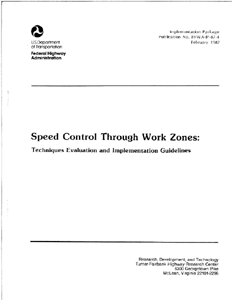Speed Control Through Work Zones: Techniques Evaluation and Implementation Guidelines
FOREWORD
Traffic accidents in highway work zones are a continuing problem. Unsafe operating speed for existing conditions is a frequently cited driver's error which contributes to work zone accidents involving highway traffic. There is a need for more effective methods for controlling c\vehicle operating speeds through highway work zones.
The information presented in this guide is of interest to traffic engineers in the public and private sectors who are involved in or responsible for planning, designing, and implementing traffic control in highway construction zones on multilane freeways. The guide presents evaluations of four methods for controlling vehicle speeds through work zones on multilane highways where one or more lanes are closed.
The basis for this guide was a field study of vehicle operating speeds through work zones on segments of Interstate highways in Delaware. Copies of the guide are available from the National Technical Information Service, Springfield, Virginia 22161.
Robert J. Betsold
Director, Office of Development
Federal Highway Administration

PDF Version (5.64 MB)
PDF files can be viewed with the Acrobat® Reader®
TECHNICAL REPORT DOCUMENTATION PAGE
| 1. Report No. FHWA–IP–87–004 |
2. Government Accession No. |
3. Recipient's Catalog No. |
| 4. Title and Subtitle
Speed Control Through Work Zones: Techniques Evaluation and Implementation Guidelines
|
5. Report Date February 1987 |
| 6. Performing Organization Code |
| 7. Author(s) Errol C. Noel, Conrad L. Dudek, Olga J. Pendleton, Hugh W. McGee, Ziad A. Sabra |
8. Performing Organization Report No. |
9. Performing Organization Name and Address
|
Contractor: Daniel Consultants, Inc. Columbia, Maryland
Subcontractor: Dudek & Assoc., Bryan, Texas
Belmo-McGee, Vienna, Virginia
|
|
10. Work Unit No. (TRAIS) FCP 31ZA318 |
| 11. Contract or Grant No. DTFH61–85–C–00163 |
| 12. Sponsoring Agency Name and Address
Office of Implementation Research,
Development and Technology
Federal Highway Administration
Washington, D.C. 20590
|
13. Type of Report and Period Covered
Final Report
Sept. 1985 – Feb. 1987
|
| 14. Sponsoring Agency Code |
|
15. Supplementary Notes
FHWA Contract Manager: William L. Williams, P.E., HRT–20
FHWA Contract Administrator: Ann G. Argaman, HCP–42
|
| 16. Abstract
This report presents the implementation and evaluation of four techniques for improving the effectiveness of speed zoning in construction areas on
multilane freeways. The techniques are (a) the flagging procedure of the Manual On Uniform Traffic Control Devices
(MUTCD), (b) the use of the MUTCD flagging procedure as well as motioning motorists to slow and pointing at a nearby speed limit sign with the free hand
of the flagger, (c) a marked police car with cruiser lights and radar active, and (d) a uniformed police officer standing to control traffic. Each of the
techniques were applied continuously on six-lane freeways for a period of 10-15 days. The results of the analysis indicate that all four techniques can
derive significant reduction in traffic speed through highway construction zones. The flagging methods were effective in construction areas where one lane
remained open to traffic. The law enforcement methods demonstrated a stronger speed reduction capability, particularly when the lane closures result in two
or more lanes open. The construction projects used for the field data collection required speed reduction from the regulatory 55 m.p.h. to an advisory 45
m.p.h. Although the law enforcement techniques were determined to be effective, their implementation requires a high degree of administratice coordination
and cooperation involving police departments, highway officials and construction contractors. A User Guide on speed control in work zones is provided in
Appendix B.
|
| 17. Key Words
Speed Control, Work Zone Safety, Speed Zoning, Highway Speed
|
18. Distribution Statement
No restrictions. This document is available to the public through the National Technical Information Service, Springfield, VA 22161.
|
| 19. Security Classification (of this report) Unclassified |
20. Security Classification (of this page) Unclassified |
21. No. of Pages 52 |
22. Price A04 |
| Form DOT F 1700.7 (8-72) |
Reproduction of completed page authorized |
FHWA-IP-87-004
|
